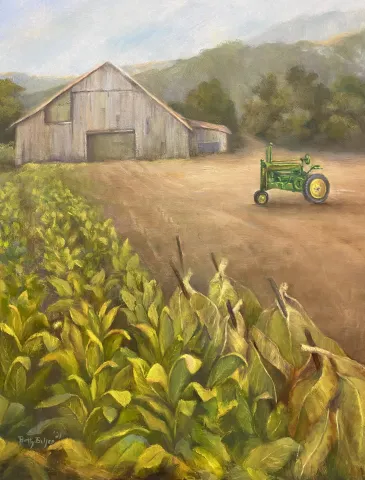"Cutting Time" by Betty Bullen is Heritage Fest collectible print

"Cutting Time," the 2021 Union County Heritage Festival collectible print by Betty Bullen
When the Union County Heritage Festival (UCHF) committee announced the theme for the 2021 Heritage Festival to be "Take A Country Road," my mind immediately went to what a one might have seen as he or she traveled down a country road in Union County some fifty-plus years ago. For sure, one would have seen a tobacco patch, or 'bakker patch' as it might have been called back then.
Tobacco was the primary cash crop for farmers in Union County and surrounding counties for years. The process of growing tobacco was a year long and usually started in February with burning the tobacco beds and sowing the seeds. Long white canvas was stretched over those beds to protect the young tender plants. Then come May those plants would be pulled from the beds and planted in rows in the 'bakker patch,' The summer work ahead would include plowing, hoeing, suckering, topping and worming the plants.
Of course the work was all done by hand. Most young men and a few young ladies can remember the blackish-brown wax buildup on their hands from working in the tobacco. In late summer those plants would be head high and start turning from a well-recognized tobacco green to ripe yellow. The change in color signaled this was "Cutting Time."
The plants were cut, speared onto sticks and hung in the barn to cure. After six to ten weeks of curing, the leaves were stripped from the stalk, graded and tied into 'hands.'
The grades were generally referred to as tips, short red, long red and trash, or tips, leaf, lugs and flyings. The grading of tobacco was commonly referred to as 'handing time' or 'hand-off.' These hands were packed onto flat, square tobacco baskets and hauled to market. Union County farmers generally took their tobacco to a Tazewell or Knoxville tobacco warehouse for sale.
Representatives from numerous tobacco companies such as R.J. Reynolds would follow the auctioneer down the rows of baskets and bid for the tobacco. Farmers would wait on the sideline and hoped to get a good price per pound for their crop. The tobacco warehouse would take a cut of the sale price and then a check would be given to the farmer. The much awaited 'tobacco check' would assure a good Christmas for most kids, new shoes for school, and some put back to hold the family over until the next season. In the winter, the process all started over with the ground being turned waiting for next year's crop to be planted.
Government regulations were placed on tobacco growing either by poundage quotas or acreage allotments that limited how much farmers could grow and eventually provided price supports.
In 2004, the 'Tobacco Buyout Bill,' officially named Fair and Equitable Tobacco Reform, ended the Depression-Era tobacco quota program. Quota and price support programs ended, effective with the 2005 crop. The buyout provided annual transitional payments for 10 years to eligible tobacco quota holders and producers.
Tobacco was the most lucrative crop per acre that a farmer could grow and there are still tobacco producers today. James and Lora Tharp, the last commercial tobacco growers in Union County, sowed their last crop about two years ago. The 2021 Agricultural Census shows 10,014 tobacco farmers in the U.S. using approximately 342,932 acres of ground. North Carolina leads the U.S. producing over 184 million pounds in 2020. China leads the world's production of tobacco.
The 2021 Union County Heritage Festival print, "Cutting Time," is the creation of reknowned artist Betty Bullen. This print is available on festival day, October 2, at Booth 65 in Wilson Park. This print and past collectible prints are available at Janet's Hair and Nail Salon, The Winery at Seven Springs Farm and from the artist by emailing bullenart@aol.com. The cost is $20 and proceeds help to fund the UCHF Art Show and other festival activities.
- Log in to post comments